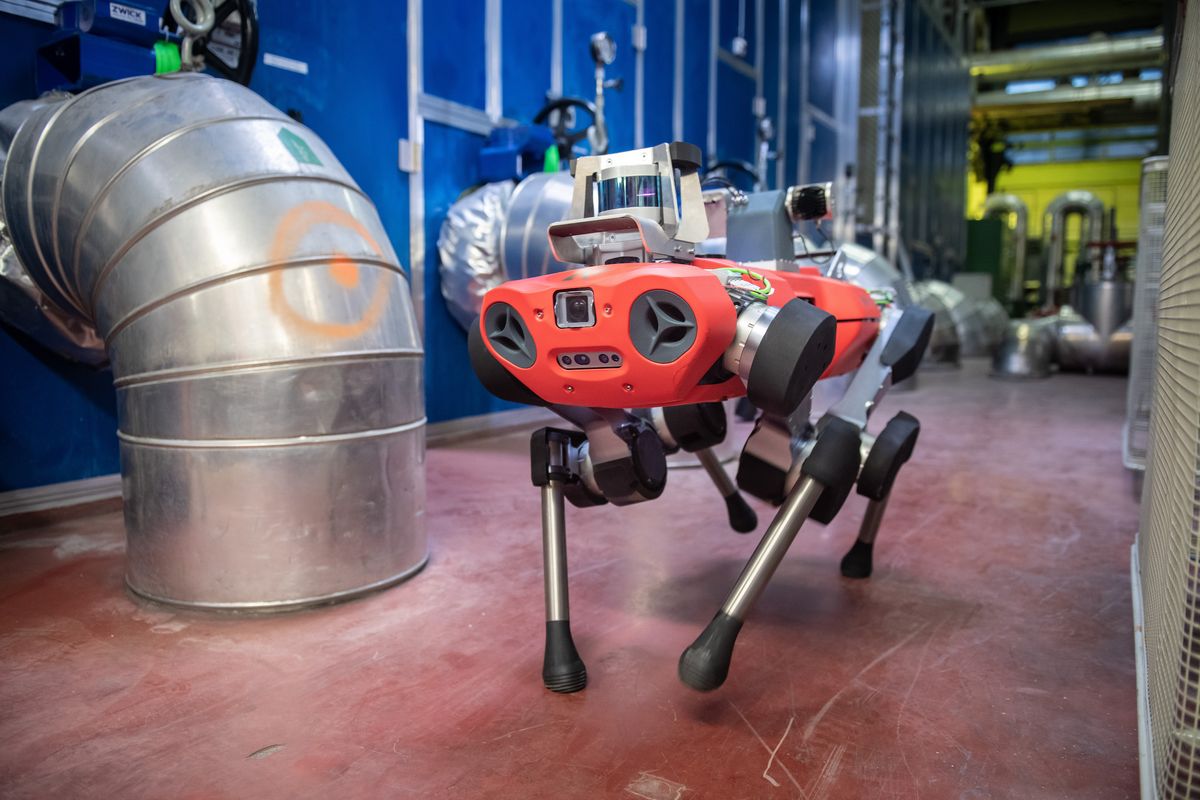Quadrupedal robots are making significant advances lately, and just in the past few months we’ve seen Boston Dynamics’ Spot hauling a truck, IIT’s HyQReal pulling a plane, MIT’s MiniCheetah doing backflips, Unitree Robotics’ Laikago towing a van, and Ghost Robotics’ Vision 60 exploring a mine. Robot makers are betting that their four-legged machines will prove useful in a variety of applications in construction, security, delivery, and even at home.
ANYbotics has been working on such applications for years, testing out their ANYmal robot in places where humans typically don’t want to go (like offshore platforms) as well as places where humans really don’t want to go (like sewers), and they have a better idea than most companies what can make quadruped robots successful.
This week, ANYbotics is announcing a completely new quadruped platform, ANYmal C, a major upgrade from the really quite research-y ANYmal B. The new quadruped has been optimized for ruggedness and reliability in industrial environments, with a streamlined body painted a color that lets you know it means business.
ANYmal C’s physical specs are pretty impressive for a production quadruped. It can move at 1 meter per second, manage 20-degree slopes and 45-degree stairs, cross 25-centimeter gaps, and squeeze through passages just 60 centimeters wide. It’s packed with cameras and 3D sensors, including a lidar for 3D mapping and simultaneous localization and mapping (SLAM). All these sensors (along with the vast volume of gait research that’s been done with ANYmal) make this one of the most reliably autonomous quadrupeds out there, with real-time motion planning and obstacle avoidance.

ANYmal C is also one of the ruggedest legged robots in existence. The 50-kilogram robot is IP67 rated, meaning that it’s completely impervious to dust and can withstand being submerged in a meter of water for an hour. If it’s submerged for longer than that, you’re absolutely doing something wrong. The robot will run for over 2 hours on battery power, and if that’s not enough endurance, don’t worry, because ANYmal can autonomously impale itself on a weird cone-shaped docking station to recharge.

As far as what ANYmal C is designed to actually do, it’s mostly remote inspection tasks where you need to move around through a relatively complex environment, but where for whatever reason you’d be better off not sending a human. ANYmal C has a sensor payload that gives it lots of visual options, like thermal imaging, and with the ability to handle a 10-kilogram payload, the robot can be adapted to many different environments.
Over the next few months, we’re hoping to see more examples of ANYmal C being deployed to do useful stuff in real-world environments, but for now, we do have a bit more detail from ANYbotics CTO Christian Gehring.
IEEE Spectrum: Can you tell us about the development process for ANYmal C?
Christian Gehring: We tested the previous generation of ANYmal (B) in a broad range of environments over the last few years and gained a lot of insights. Based on our learnings, it became clear that we would have to re-design the robot to meet the requirements of industrial customers in terms of safety, quality, reliability, and lifetime. There were different prototype stages both for the new drives and for single robot assemblies. Apart from electrical tests, we thoroughly tested the thermal control and ingress protection of various subsystems like the depth cameras and actuators.
What can ANYmal C do that the previous version of ANYmal can’t?
ANYmal C was redesigned with a focus on performance increase regarding actuation (new drives), computational power (new hexacore Intel i7 PCs), locomotion and navigation skills, and autonomy (new depth cameras). The new robot additionally features a docking system for autonomous recharging and an inspection payload as an option. The design of ANYmal C is far more integrated than its predecessor, which increases both performance and reliability.
How much of ANYmal C’s development and design was driven by your experience with commercial or industry customers?
Tests (such as the offshore installation with TenneT) and discussions with industry customers were important to get the necessary design input in terms of performance, safety, quality, reliability, and lifetime. Most customers ask for very similar inspection tasks that can be performed with our standard inspection payload and the required software packages. Some are looking for a robot that can also solve some simple manipulation tasks like pushing a button. Overall, most use cases customers have in mind are realistic and achievable, but some are really tough for the robot, like climbing 50° stairs in hot environments of 50°C.
Can you describe how much autonomy you expect ANYmal C to have in industrial or commercial operations?
ANYmal C is primarily developed to perform autonomous routine inspections in industrial environments. This autonomy especially adds value for operations that are difficult to access, as human operation is extremely costly. The robot can naturally also be operated via a remote control and we are working on long-distance remote operation as well.
Do you expect that researchers will be interested in ANYmal C? What research applications could it be useful for?
ANYmal C has been designed to also address the needs of the research community. The robot comes with two powerful hexacore Intel i7 computers and can additionally be equipped with an NVIDIA Jetson Xavier graphics card for learning-based applications. Payload interfaces enable users to easily install and test new sensors. By joining our established ANYmal Research community, researchers get access to simulation tools and software APIs, which boosts their research in various areas like control, machine learning, and navigation.
[ ANYmal C ]
Evan Ackerman is a senior editor at IEEE Spectrum. Since 2007, he has written over 6,000 articles on robotics and technology. He has a degree in Martian geology and is excellent at playing bagpipes.



